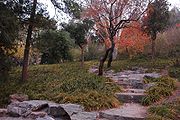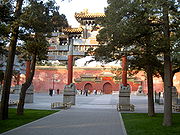
Jingshan Park
Encyclopedia


Beijing
Beijing , also known as Peking , is the capital of the People's Republic of China and one of the most populous cities in the world, with a population of 19,612,368 as of 2010. The city is the country's political, cultural, and educational center, and home to the headquarters for most of China's...
, China
China
Chinese civilization may refer to:* China for more general discussion of the country.* Chinese culture* Greater China, the transnational community of ethnic Chinese.* History of China* Sinosphere, the area historically affected by Chinese culture...
. Covering an area of more than 230,000 m², Jingshan is immediately north of the Forbidden City
Forbidden City
The Forbidden City was the Chinese imperial palace from the Ming Dynasty to the end of the Qing Dynasty. It is located in the middle of Beijing, China, and now houses the Palace Museum...
on the central axis of Beijing. As a result, it is administratively part of both the Xicheng District
Xicheng District
Xicheng District is a district in Beijing, China. Xicheng District spans 32 square kilometres, making it the largest portion of the old city , and has 706,691 inhabitants . Its postal code is 100032. Xicheng is subdivided into 15 subdistricts of the city proper of Beijing...
and the Dongcheng District
Dongcheng District, Beijing
Dongcheng District is an urban district in Beijing covering the eastern half of Beijing's urban core. It is 24.7 square kilometres in area and has a population of 535,558 . Dongcheng District covers several important parts of Beijing...
. Originally an imperial garden, it is now a public park, known as Jingshan Park (景山公园).
The 45.7-metre high artificial hill was constructed in the Yongle era of the Ming Dynasty
Ming Dynasty
The Ming Dynasty, also Empire of the Great Ming, was the ruling dynasty of China from 1368 to 1644, following the collapse of the Mongol-led Yuan Dynasty. The Ming, "one of the greatest eras of orderly government and social stability in human history", was the last dynasty in China ruled by ethnic...
entirely from the soil excavated in forming the moats of the Imperial Palace and nearby canals. It is especially impressive when one considers that all of this material was moved only by manual labor and animal power. Jingshan consists of five individual peaks, and on the top of each peak there lies an elaborate pavilion. These pavilions were used by officials for gathering and leisure purposes. These five peaks also draws the approximate historical axis of central Beijing.
According to the dictates of Feng Shui
Feng shui
Feng shui ' is a Chinese system of geomancy believed to use the laws of both Heaven and Earth to help one improve life by receiving positive qi. The original designation for the discipline is Kan Yu ....
, it is favorable to site a residence to the south of a nearby hill (and it is also practical, gaining protection from chilly northern winds). The imperial palaces in the other capitals of previous dynasties were situated to the south of a hill. When the capital was moved to Beijing
Beijing
Beijing , also known as Peking , is the capital of the People's Republic of China and one of the most populous cities in the world, with a population of 19,612,368 as of 2010. The city is the country's political, cultural, and educational center, and home to the headquarters for most of China's...
, no such hill existed at this location, so one was constructed. It is popularly known as Feng Shui Hill. It is also known as Coal Hill, a direct translation of its old popular Chinese name .
The last emperor of the Ming Dynasty
Ming Dynasty
The Ming Dynasty, also Empire of the Great Ming, was the ruling dynasty of China from 1368 to 1644, following the collapse of the Mongol-led Yuan Dynasty. The Ming, "one of the greatest eras of orderly government and social stability in human history", was the last dynasty in China ruled by ethnic...
, Chongzhen
Chongzhen Emperor
The Chongzhen Emperor was the 16th and last emperor of the Ming Dynasty in China. He reigned from 1627 to 1644, under an era name that means "honorable and auspicious".- Early years :...
, committed suicide by hanging himself here in 1644.
Jingshan is especially a popular place for elderly people socializing and gathering. One can often find elderly folks dancing, singing opera and doing other cultural activities, such as kuai ban, at Jingshan.
Relationship with the Forbidden City
Jingshan hill is separated from the Forbidden CityForbidden City
The Forbidden City was the Chinese imperial palace from the Ming Dynasty to the end of the Qing Dynasty. It is located in the middle of Beijing, China, and now houses the Palace Museum...
by the palace moat. However, until 1928 the park sat directly by the moat and was accessible on the south side only from the Forbidden City via the Gate of Divine Might
Gate of Divine Might
The Gate of Divine Might or Gate of Divine Prowess is the northern gate of the Forbidden City in Beijing, China. It faces Jingshan Park. A tablet above the doorway reads "The Palace Museum" in Chinese....
. In 1928, a new road (New Jinghshan St) was built to the north of the palace moat. This fully separated Jingshan Hill from the Forbidden City. The Gate of Divine Might became the back door of the Palace Museum, and the front gate of Jingshan Park now stood to the north of the new road.
The street addresses of both the Forbidden City and Jingshan Park are on New Jingshan St.
See also
- Guilty Chinese ScholartreeGuilty Chinese ScholartreeThe Guilty Chinese Scholartree , a specimen of Pagoda Tree located in Beijing's Jingshan park, is a famous tree and national landmark on which the last Ming Chongzhen Emperor hanged himself after a group of peasants successfully stormed the Forbidden City in 1644.The tree was uprooted during the...
- Tourist Attractions of BeijingTourist attractions of BeijingThere are many landmarks in Beijing. The best-known ones include the Badaling stretch of the Great Wall of China, the Temple of Heaven, the Tian'anmen and the Forbidden City, a number of temples, hutongs and parks, relics of ages gone by....

